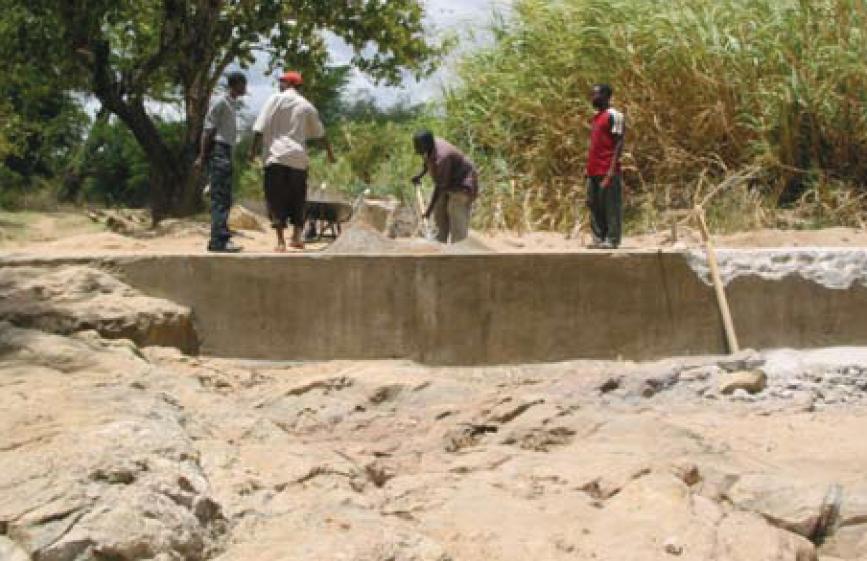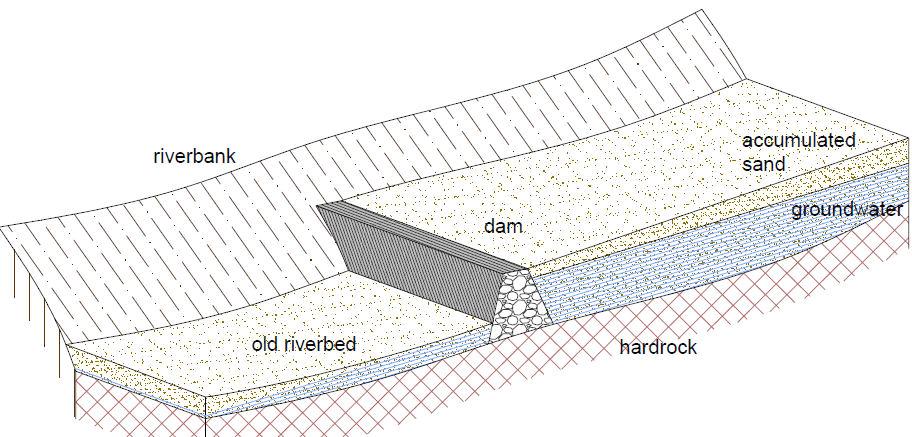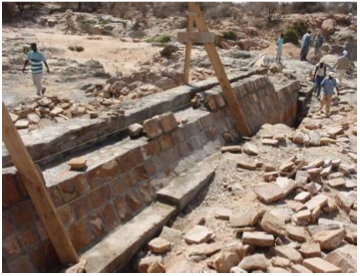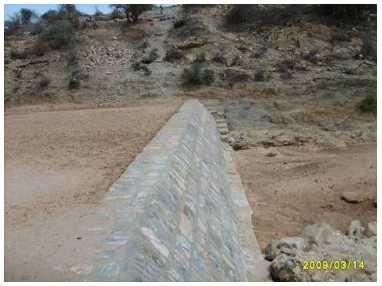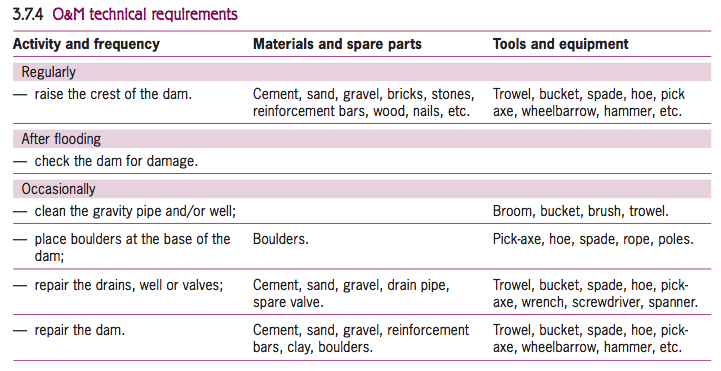Difference between revisions of "沙坝"
| Line 73: | Line 73: | ||
'''干旱效应''':会干涸;出水量低。 <br> | '''干旱效应''':会干涸;出水量低。 <br> | ||
'''潜在的因果关系''':减少的降雨量会降低砂石含水层的补充。上升的人口和用水需求;砂石含水层的大小,如,有限的沙量;坝后积聚了太多淤泥;井不够深,未达地下水位;选址不当,引发水坝泄漏。<br> | '''潜在的因果关系''':减少的降雨量会降低砂石含水层的补充。上升的人口和用水需求;砂石含水层的大小,如,有限的沙量;坝后积聚了太多淤泥;井不够深,未达地下水位;选址不当,引发水坝泄漏。<br> | ||
| − | '''提高水、环境卫生与个人卫生系统的适应力''' | + | '''提高水、环境卫生与个人卫生系统的适应力''':选址和建造符合要求;分阶段建坝以减少淤泥;在上游流域运用土地和水源保护技术;将抽水井或取水管道挖得更深。 |
| − | + | 点击链接了解应对干旱的更多详情:[[Resilient WASH systems in drought-prone areas]]. | |
====Floods==== | ====Floods==== | ||
Revision as of 05:14, 31 August 2015
沙坝是一种建造简便、成本低、维护工作量少、易复制再造的雨水收集技术。沙坝为家庭及农场提供清洁的当地用水,适用于全球的半干旱地区。
在降雨量极不稳定的地区,通常砂质河床上会有季节性水流临时流经。这些地区只在雨后才有短时大量的径流,而大量的沙会在这一时段被带到下游。在流动过程中,一些沙会被阻挡在上游突出的岩石处,于是,天然水中的这些沙子便形成砂石含水层。沙坝技术由此应运而生,重现这种集水机制,扩大现有的砂石含水层规模。
天然集水的区域通常汇集了清洁的饮用水,但数量有限,很快便会耗尽。而沙坝对砂质河床进行了人工改进,能补给、储存更多水,以供备用。用混凝土、黏土或石材在河道的一些特定处建造水坝,为的是能在洪水期间留住沙子;这样便创造了额外的地下水储备,在旱季得以利用。
如果选址准确适宜,沙坝中可用的总水量至少有6000立方米。
沙坝项目不仅提高了水的可供性,也有利于社区的社交和经济。当地人会获得培训,参与建设和维护沙坝,并管理财务和自然资源。
适宜条件
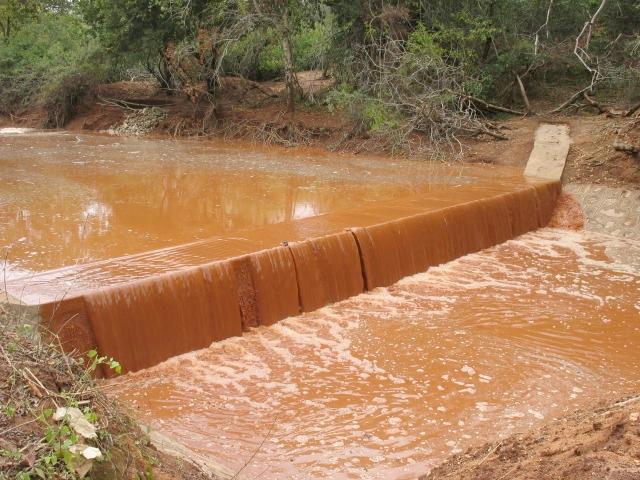
沙坝可因家庭、社区甚至市政用途建造使用。有些沙坝通过渗渠、排水井和泵站与市政水管系统连接。
然而,选定建坝的最佳位置需要专业知识的投入,确保项目能适应当地社区的实地条件和社会环境。在每一个集水区设立一位工匠领队来进行选址或可提高成功率。从实际出发,选址必须适宜建造沙坝,能提供安全的饮用水,也能利用沙子的沉积增加水的供给。首先,必须判定河流是否适宜;第二,必须选择河床的最佳区段;随后,确定最佳选址。
通常而言,沙坝需要建在丘陵地带中的砂质河床上。河床最好有不透水的基岩,上面铺有粗砂。河流需是季节性的,但必须有基本流量。要判断河流是否符合上述条件,可以观察生长在河边的植被种类。河流不能太宽(最宽25米),两边需要有较高的河堤。
请确保把沙坝建在河水会流经坝体的区域,两边河堤要等高,高度要足够(坝高+洪水水位+10%),且不要把沙坝建在河流弯道附近。
以下选址能防止漏水:
- 要有非渗透性的基岩或黏土,而非有裂缝的石头。一个实用的判断指征是,在旱季是否有先前就存在的地下水流,并且,在河床上是否有较大的岩石和卵石。选址时需要特别留意,因为在这些情况下,沙坝下方可能会出现渗漏。
- 选址在基层上,而非在沙中的黏土透镜体上。
- 要在确定的河堤间,若河堤任一边有旧河床,则需确保旧河床不会使沙坝边缘有地下水存在。
要选择斜度适宜留住沙子而不是淤泥的地方建坝。水流速度至少要达到每秒0.45米才会留下较少淤泥,因此,这样的区域就需要斜坡角度适宜——若太平便会有太多小颗粒和淤泥。坡度越平,河床便越宽,而建沙坝必须要25米以下的河宽。据说最佳的斜度是在0.125%至4%之间;虽然也可以高于4%的值,但会造成沙储备量减少。若想要确定粒径分布,沙子分析是一种较简易的实地检测方法,或者可以通过孔隙率和单位出水量测试来推断沙子可能的类型。中粒砂可以最好地平衡孔隙率和单位出水量,因此是最需要的类型。
如果河流较窄,并有阻挡地下水的天然屏障,这样的选址因沙量已达最多,能降低建坝成本。要找到这样的屏障,可以通过观察雨后积水在勺状孔中的位置,或通过探针、螺旋钻和浅探井,或空气压缩机钻孔等方法。
避免在上游河堤有盐岩(呈白色和粉红色)的区域选址,否则会使水中含盐。
在同一条河上建坝要有秩序,以避免所有人过度使用同一水源,造成可能的生态破坏。而坝间距太近则会使各自影响的区域重叠,会造成水位普遍升高,而可供使用的总水量降低。对每一区域而言,水量更为重要,因此最好设立最小坝间距(以往,肯尼亚的最小坝间距为700米,坝每边350米是影响区域,但需视不同地点而定)。
建坝适宜条件也与其它因素相关,如:气候,有无卵石,同时也必须具体分析河床倾斜度来判定选址是否合适。并且,虽然实地条件可通过人为来改善,但水质必须达到可以饮用的级别(不能含盐太多,不能受污染,等)。
| 优势 | 不足 |
|---|---|
|
- 全年都有质量优良的水源和地下水补给 |
- Site-specific technology – not suitable everywhere.这一技术适用于特定场地——并非适用于所有地点 |
顺应环境变化
干旱
干旱效应:会干涸;出水量低。
潜在的因果关系:减少的降雨量会降低砂石含水层的补充。上升的人口和用水需求;砂石含水层的大小,如,有限的沙量;坝后积聚了太多淤泥;井不够深,未达地下水位;选址不当,引发水坝泄漏。
提高水、环境卫生与个人卫生系统的适应力:选址和建造符合要求;分阶段建坝以减少淤泥;在上游流域运用土地和水源保护技术;将抽水井或取水管道挖得更深。
点击链接了解应对干旱的更多详情:Resilient WASH systems in drought-prone areas.
Floods
Sand dams require careful maintenance, and immediate repair, as flooding causes hundreds of tons of water to fall over the dam wall and onto the spill-over apron. Flood water may also spill over and erode the wing walls and, perhaps, even over the riverbanks during heavy rains. When determining the dam and spillway height at the selected location, it is very important that the water level and flood line remain below the riverbanks after construction of the dam, or that flooding will not lead to problems up or downstream of the dam. If the flood level is higher than the riverbanks, construction of a dam is not advisable.
Construction, operations and maintenance
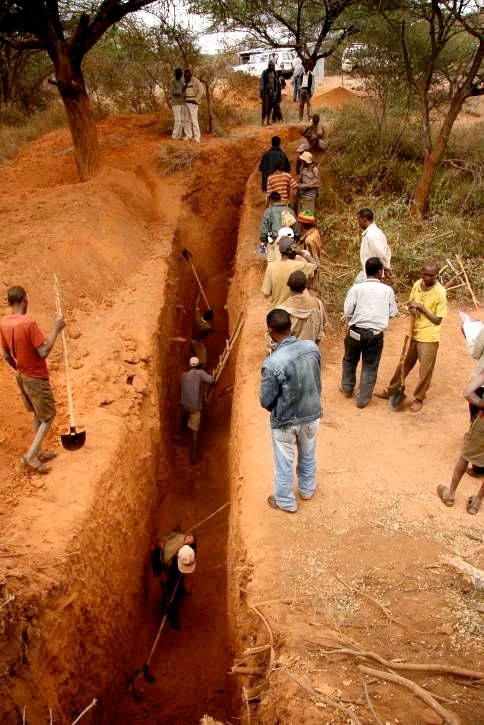
First a trench needs to be dug. Its position is marked out using pegs. Then it is excavated and the soil placed downstream. It can also be dug out into bedrock. It should then be checked for weathering zones and cracks. Round bars are placed vertically along the trench to reinforce it. Then a foundation is laid consisting of 2 layers of cement with barbed wire in between. Once this has set, the trench is filled with masonry or mortar and hardcore. The wing walls and final dam wall can then be constructed. Finally any exposed parts of the construction are plastered.
Building the sand dam (and wing wall)
General advice on cement: A common cause of cracks in structures and linings (e.g. in tanks, dams, waterways, wells) is errors in mixing and applying the cement. First of all, it is important that only pure ingredients are used: clean water, clean sand, clean rocks. The materials have to be mixed very thoroughly. Secondly, the amount of water during mixing needs to minimal: the concrete or cement needs to be just workable, on the dry side even, and not fluid. Thirdly, it is essential that during curing the cement or concrete is kept moist at all times, for at least a week. Structures should be covered with plastic, large leaves or other materials during the curing period, and kept wet regularly.
Specific advice
- Timing is important: dams should be built during the dry season, but don’t build dams too close to the rains in order to avoid the trench filling up with water or the dam being washed away.
- The method depends on the type of dam and the type of ground. The construction of sand dams in cascades improves total storage and efficiency and minimizes seepage losses. Dams made of concrete, stone-masonry (cheapest and easiest) and brickwork require skilled labour for construction, but are stronger and have a longer lifespan.
- Usually sand dams are built onto a rock layer, but where there is no rock and only clay, it can still work but as long as the foundation is keyed into the clay layer and where the wall does not protrude more than 0.5m above original sand level, otherwise there is a risk the structure overturns during a flood event.
- Key into banks or construct wing walls to avoid erosion around edges of the sand dam. Where wing walls are built, a good technique is to start with the wing walls and work inwards to the centre, since community enthusiasm lags by the time wing walls are constructed (if not built first), yet they are essential to proper functioning. Length of the wing wall varies according to bank characteristic: loose riverbanks, 7 metres; hard soils, 5 metres; hard & impermeable soils or rocks, wing wall is not needed. Planting napier grass along upstream riverbanks controls erosion and fixes the course of the river in a flood.
- The height of wall built before each flood event should not exceed accumulation rate of coarse to medium sand during that flood event, otherwise ponding & silt deposition will occur, which can lower specific yield and higher capillarity, then lead to limited extraction rates in wells upstream and more water lost to evaporation. Dams at 1.3m depth showed that where finer material content (0.063 mm or less) is increased, specific yield is known to decrease remarkably. Accumulation rate and therefore height varies according to location and should be adjusted at each site after the first flood event demonstrates the rate of accumulation. Height per stage will probably be between 0.3 metre and 1 metre per stage according to experience from past projects. Some silt deposition will always occur as velocities decrease toward the end of the flood event; the idea is to limit its quantity in final sand volume.
- Avoid downstream erosion problems by making a protective slab (stilling basin) at the base of large stones set in concrete. Dimensions to be designed, but is not necessary where there is exposed rock bar downstream.
- In upstream parts of a catchment it is recommended that sand dams are always built in stages, since the availability of coarse material is generally limited and base flow is small or absent (base flow = sub-surface flow which aids surface flow so that silt/clay can still be flushed away once rainfall stops, rather than sinking directly into the sand bed). It has also been suggested that to build in stages over several years is also more beneficial for functioning of dam committees. Build them within a spillway, which was part of the first stage & wing wall construction.
Water extraction
After the dam is built, an outlet for water extraction must be constructed for drinking, agriculture, etc. Hand dug scoop holes are the simplest possibility, however the water can easily be contaminated. Covered shallow wells, either with or without Handpumps or a Rope pump protect the water much better. It is also possible to construct an outlet pipe with a tap. In certain designs for sand dams, a pipe is shown that takes water by gravity through the dam wall. These are said to not work well due to either a blocked intake, a broken tap on outlet side and the possibility of weakening the dam wall. Where water is abstracted directly, risk of contamination increases. In such a case, household water treatment should be advocated (e.g. Sodis).
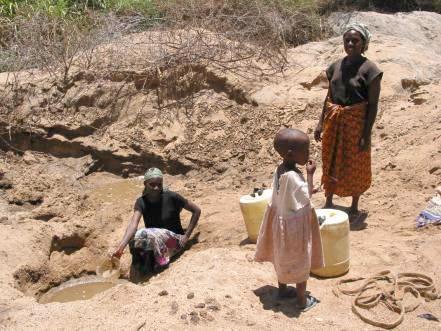
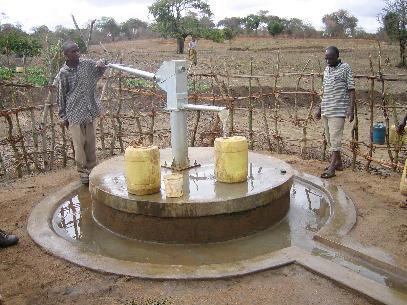
Maintenance
If done timely, the maintenance required is not costly. Small malfunctions in the dam however can lead to destruction of the entire dam. Therefore, the dam should be regularly checked for cracks and damage. Particularly after floods, and extreme temperature changes cracks are likely. These need to be repaired as soon as possible by a trained mason. During the dry season, raised-sand dams should be raised by a maximum of 50 cm if the reservoir has filled up.
Further, the outlet and upstream riverbed should be cleaned regularly to make sure the dam does not get blocked. Silt, rocks, dead animals, etc. should be removed regularly. This can also help prevent contamination of the water. The quality of the water in the well should be checked, once in a while, by an expert.
Maintenance can normally be carried out by the users of the system or by a caretaker or watchman. Larger repairs may require skilled labour, which can usually be provided by local craftsmen. In some cases, unskilled labour may be required on a large scale (e.g. for repairing a broken raised-sand dam, or a leaking subsurface dam). The labour may be provided by the users (with or without pay), or by other people who are hired for the purpose. Users may need to establish a local committee to manage issues, such as controlling or supervising water use, preventing water contamination, carrying out O&M activities, financing O&M, and monitoring how much stored water is still available (a piezometer or auger hole may be installed to allow a caretaker or watchman to estimate how much water is left and decide if rationing has to be introduced). Proper management may also help to prevent social conflict. For O&M tasks at the dam site, a person who lives or farms near this site could be appointed. This person could also be responsible for water allocation and be involved in monitoring activities, if users obtain the water near to, or at, the site. His or her authority should be clear and accepted by all users.
In order to insure success at all stages of construction, operations and maintenance, the local community needs to be trained as well to manage and maintain the dam. Promote catchment-level planning & management so that varying groups have a vested interest in the same source. They can start to address improvements in soil/water conservation, food production & health. Previous dam committees have shown that they tend to stop functioning effectively after the construction phase. By taking longer to build the dam, e.g. 3 stages over 3 years, it may give enough time for a catchment-based dam association to form & start functioning.
Brikke and Bredero, in their publication Linking technology choice with operation and maintenance in the context of community water supply and sanitation: A reference document for planners and project staff, recommend the following O&M activities in the chart below:
Estimated Lifespan
The lifespan depends on the materials used and expertise with which it is constructed and maintained. The dams in Kitui Kenya were built at a cost of US$7,500 and have a minimum lifespan of 50 years.
Costs
The construction of dams is largely carried out by the local community. Costs mainly relate to local availability of cement, masonry and professional supervision.
Cost of introduction:
- Material: US$ 5,500
- Other costs: US$ 500
- Labour: - skilled: US$ 2,500 - unskilled: 900 man days -
Cost of maintainance:
- Operation and maintenance: 5 days per year
The cost of a sand dam in Kenya was very low, yielding 2,844 m3 of water was US$3,260 = US$1.15 per m3 storage.
The cost to benefit ratio for the sand dam's first year of operation is 1:12.
Field experiences
In Kenya, it has been used with good outcome in the Kitui, Machakos and Samburu districts. Other countries with similar dry environments such as the U.S.A, Thailand, Ethiopia and Namibia also have used it in numerous and diverse forms.
Kitui district, Kenya: SASOL Foundation has since 1995 built over 500 dams. They are built using locally available materials and are partially (40%) financed by the local community. The community is also involved in the construction and maintenance. Sand management groups were formed to aid in the construction of dams and to maintain them after.
The dams not only provide a steady source of drinking water, but also have further social and economic benefits. They provide irrigation for cash crops and other commercial rural activities, piped water for industrial activities in nearby villages. Further due to the large number of dams, the water table rises over a large area and therefore stimulates ecological regeneration.
Borana Zone, Ethiopia: Communities in this area depend on agriculture and livestock farming, which is very limited due to the unstable water supply. In 2007 several NGOs implemented 7 sand dams and 10 surface runoff tanks. This combination should provide a reliable source of water for 10 communities in the area. The project will in the future expand to other parts of the country also.
Akvo RSR Projects
The following project utilize sand dams.
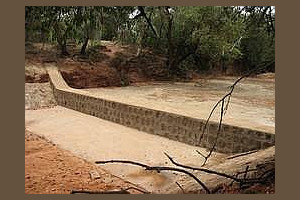 Dawa Eresa Subsurface and Sand Dam project |
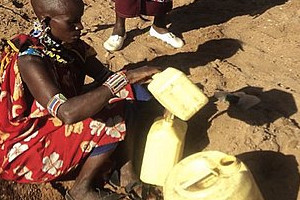 Feasibility Study for Rainwater Harvesting |
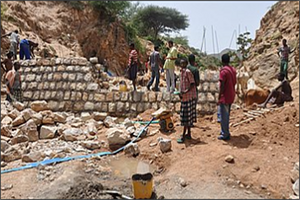 Wateroogst: Konso Woreda/Eshimale |
Manuals, videos and links
- MANUAL: A practical guide to sand dam implementation. Rainwater Harvesting Implementation Network (RAIN).
- MANUAL: Manual on sand dams in Ethiopia: A practical approach on sand dam site selection, design and construction. A tool for combining sand dams with other rainwater harvesting structures. ERHA (Ethiopian Rainwater Harvesting Association) and RAIN Foundation.
- MANUAL: Before the Deluge: Coping with Floods in a Changing Climate. How to adapt to floods caused by climate change. International Rivers Network.
- MANUAL: Sand Dams: Feasible Rainwater Harvesting Technology for Arid and Semi-arid Lands. Practical action.
- DOC: FAQs on Sand Dams. Provided by Excellent/ASDF with input from Dabane Trust.
Videos
& field visit in Ethiopia, 2009 |
Project - Kenya, 2010 |
Links
- Excellent: Pioneers of San Dams.
- ACACIA Water. The strength of Acacia Water is the specialization in the field of groundwater, while at the same time being able to place issues in a broader perspective and to link up with other fields of action. As a result we often work in a multidisciplinary environment with a broad variety of expertise.
- IAH. IAH-MAR is a forum for information on the work within the international groundwater community on the management and enhancement of aquifer recharge, a vital tool in the sustainable management of the world's underground water resources.
Acknowledgements
- CARE Nederland, Desk Study: Resilient WASH systems in drought-prone areas. October 2010.
- Brikke, François, and Bredero, Maarten. Linking technology choice with operation and maintenance in the context of community water supply and sanitation: A reference document for planners and project staff or (alternative link). World Health Organization and IRC Water and Sanitation Centre. Geneva, Switzerland 2003.
- Maddrell S and Neal I, Sand dams: a Practical Guide, Excellent Development, London. 2012.
- Jacob H. Stern, Ph.D and Alvera Stern, Ed.D, et al. Water Harvesting Through Sand Dams. ECHO Technical Note. 2011
